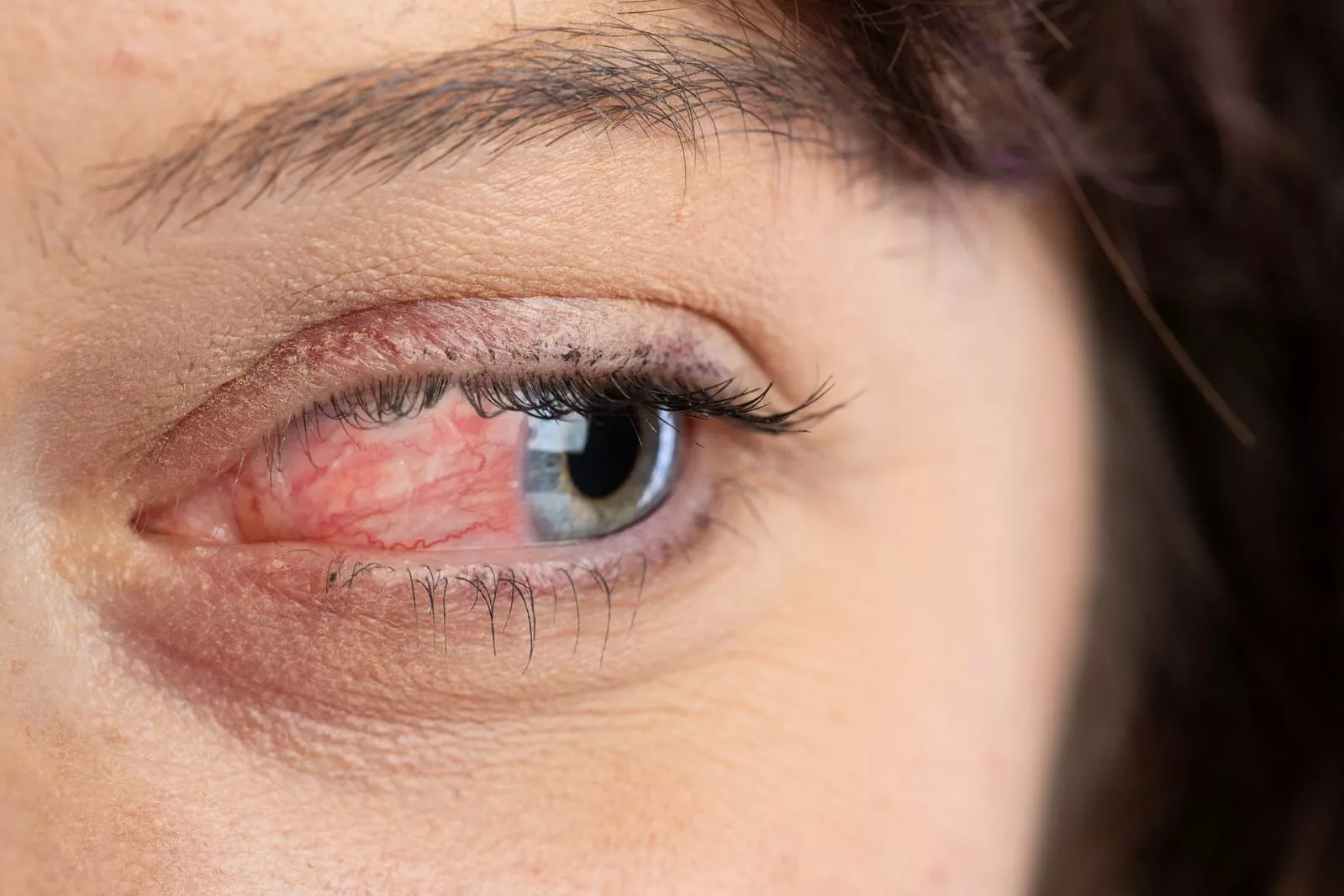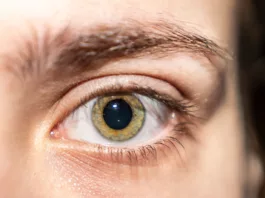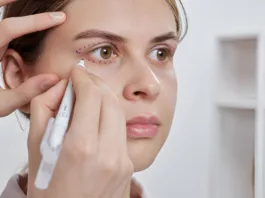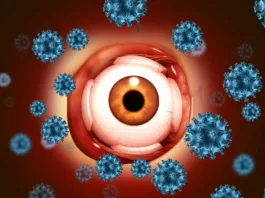What is Ocular Rosacea?
Ocular Rosacea is an inflammatory condition of the eye that results in redness and a burning, itching, and stinging sensation. It is one of the manifestations of the chronic disorder of rosacea, a long-standing inflammatory condition of the skin primarily affecting the periocular and centro-facial area. It can less frequently spread to the scalp and body. It is sometimes also referred to as Meibomian Gland dysfunction (MGD).
Four subtypes of rosacea have been defined by the National Rosacea Society committee: Papulopustular, Phymatous, Ocular, and Erythematotelangiectatic.1Chairman, J., MD, M., Detmar, M., Drake, L., Feinstein, A., Odom, R., & Powell, F. (n.d.). Standard classification of rosacea: Report of the National Rosacea Society Expert Committee on the Classification and Staging of Rosacea. ScienceDirect. https://www.sciencedirect.com/science/article/abs/pii/S0190962202426977
This condition is seen in around 70% of the cases of rosacea, of which the majority are females, mainly those with lighter skin tones.( Fitzpatrick I-II).2Tidman M. J. (2014). Improving the management of rosacea in primary care. The Practitioner, 258(1775), 27–3
What Causes Ocular Rosacea?
The exact cause behind the ocular manifestation of rosacea is not clearly understood.
However, research suggests that tear fluids from individuals with ocular rosacea show elevated levels of interleukin-1α and -β, along with increased activity of gelatinase B (metalloproteinase [MMP]-9) and collagenase-2 (MMP-8). These findings suggest a potential link to autoimmune issues in the pathogenesis of ocular rosacea.3 Veira, A. C., & Mannis, M. J. (n.d.). Ocular rosacea: Common and commonly missed. ScienceDirect. https://www.sciencedirect.com/science/article/abs/pii/S0190962213004349
Additionally. factors like genetics, environmental triggers, immune system responses, and vascular issues are believed to play a role. The causes and triggers can include:
- Sunlight
- Stress
- Spicy foods
- Alcohol
- Saunas
- Certain skincare products
- Hot beverages
- Extreme temperatures (hot or cold)
- Certain medications- topical steroids, Vitamin B3, vasodilators, beta-blockers
- Bacterial Infections- Helicobacter pylori, Demodex bravis, S. epidermidis, and Demodex folliculorum are all suspected as probable causative agents4Vieira, A. C., Höfling-Lima, A. L., & Mannis, M. J. (2012).Ocular rosacea–a review. Arquivos brasileiros de oftalmologia, 75(5), 363–369. https://doi.org/10.1590/s0004-27492012000500016
- Eyelash mites – tiny mites that live near the hair follicles of humans, most commonly around eyelashes and eyebrows. While they are usually harmless, in some cases, such as ocular rosacea, they can increase in number and cause intense irritation to the eye, including itching, burning, and redness.
- Meibomian gland dysfunction – tiny oil glands located along the edge of eyelids and eyelashes
- Environmental Factors
- Autoimmune issues
Incidence of Ocular Rosacea
The incidence can range from 6% to 72%, with ophthalmology clinics reporting a higher prevalence than dermatology clinics in individuals with rosacea.5Vieira, A. C., Höfling-Lima, A. L., & Mannis, M. J. (2012). Ocular rosacea–a review. Arquivos brasileiros de oftalmologia, 75(5), 363–369. https://doi.org/10.1590/s0004-27492012000500016 Ocular rosacea has been recorded worldwide up to this point, although extensive epidemiological research is still lacking to give an exact estimation of the burden of the disease.
What are the Symptoms of Ocular Rosacea?
Ocular rosacea usually presents with non-specific symptoms. It is difficult to rule out rosacea only through the ocular symptoms. A definitive diagnosis can only be made after other pathologies have been ruled out.
Some of the most common, non-specific symptoms include:
- Itching, gritty feeling in the eyes- patients report having some dust/foreign object in the eyes
- Dryness
- Blurred vision
- Light sensitivity
- Excessive tearing
- Burning
- Appearance of bloodshot eyes
- Swollen eyes
Typical findings in ocular rosacea occurring due to meibomian gland- dysfunction include:
- Periocular erythema: this refers to redness around the periphery of the eye.
- Conjunctivitis (pink eye): This condition includes inflammation/infection of the conjunctiva, a thin, transparent tissue layer that covers the outermost layer of the eye, the sclera. It further causes symptoms such as discharge, itching, tearing, and blurry vision.
- Scarring/ loss of meibomian gland opening
Severe Ocular Symptoms:
Other, more severe ocular manifestations of rosacea can include6Vieira, A. C., Höfling-Lima, A. L., & Mannis, M. J. (2012). Ocular rosacea–a review. Arquivos brasileiros de oftalmologia, 75(5), 363–369. https://doi.org/10.1590/s0004-27492012000500016
- Lid Margin Telangiectasia:
This refers to the appearance of small, dilated blood vessels at the edge of the eyelids. - Blepharitis:
In this, a swollen, itchy, and inflamed eye is seen. It gives the eye an immense irritation and a gritty feeling. Other causes of blepharitis include bacterial infection, clogged oil glands near the base of the eyelashes, or allergies. - Sclerokeratitis:
The sclera is the outermost layer of the eye, and keratitis refers to the inflammation of the cornea. So, in this condition, both the sclera and cornea are inflamed. This can result in severe eye pain, blurriness, sensitivity to light, and vision issues. It can also result in thickening of the corneal stroma. - Scleritis:
Scleritis is a condition that causes pain, irritation, and inflammation of the sclera. If left untreated, it can also result in vision problems.
Scleritis and sclerokeratitis can also be caused by autoimmune diseases, infections, allergies, or eye injuries. Other extreme manifestations of ocular rosacea can include corneal ulcers, repetitive erosions, and corneal perforations if left untreated.
Difference between Ocular Rosacea & Conjunctivitis
While Ocular Rosacea is a chronic inflammatory condition, conjunctivitis is usually acute, short-lived, and often caused by allergy, viral, or bacterial infection.
Conjunctivitis is usually limited to the conjunctiva; however, rosacea can affect the eye deeply, often extending enough to dampen vision as well if not treated and managed promptly.
Ocular rosacea has a longer duration, with a high chance of recurrence. Conversely, conjunctivitis resolves with appropriate management and has little to no chance of recurring.
Grading of Ocular Rosacea
A report of the National Rosacea Society Expert Committee proposed the following grading system:7Wilkin, J., Dahl, M., Detmar, M., Drake, L., Liang, M. H., Odom, R., Powell, F., & National Rosacea Society Expert Committee (2004). Standard grading system for rosacea: report of the National Rosacea Society Expert Committee on the classification and staging of rosacea. Journal of the American Academy of Dermatology, 50(6), 907–912. https://doi.org/10.1016/j.jaad.2004.01.048
Grade 1:
Itchy, dry eyes; minute scaling and redness around the ocular margin; mild congestion in vessels of conjunctiva.
Garde 2:
There is a feeling of burning in the eyes, crusty lid margins, along with redness and swelling, and chalazion or stye formation.
Grade 3:
Ocular pain; light sensitivity; blurry vision with the potential to lose vision; loss of lashes; corneal ulcers; inflammation of the sclera and iris.
Diagnosis
Ocular rosacea lacks a specific test or method of diagnosis due to its non-specific eye symptoms. Doctors typically combine a thorough medical history, evaluation of presenting symptoms, and examination of any skin manifestations with a detailed eye examination using a specialized microscope called a slit lamp to make the diagnosis. During this examination, doctors thoroughly inspect every aspect of the eye, including the borders, eyelids, and lashes. Since this condition often affects the meibomian glands, they also apply gentle pressure to these glands to assess their function.8 Veira, A. C., & Mannis, M. J. (n.d.). Ocular rosacea: Common and commonly missed. ScienceDirect. https://www.sciencedirect.com/science/article/abs/pii/S0190962213004349
Unfortunately, no serologic or histological tests are available to diagnose ocular rosacea. However, researchers are trying to form a glycomic test for ocular fluid to diagnose this condition more easily, given there is consensus that individuals with ocular rosacea present with high levels of oligosaccharides in their tear fluid, which can be considered as a diagnostic marker for this condition.9Glycomics Analyses of Tear Fluid for the Diagnostic Detection of Ocular Rosacea Hyun Joo An, Milady Ninonuevo, Jennifer Aguilan, Hao Liu, Carlito B. Lebrilla, Lenio S. Alvarenga, and Mark J. Mannis Journal of Proteome Research 2005 4 (6), 1981-1987 DOI: 10.1021/pr0501620
Ocular Rosacea Treatment
Despite extensive efforts to manage rosacea and improve quality of life, no definitive cure for ocular rosacea exists. Management remains primarily symptomatic. Some of the most common methods utilized in the management of ocular rosacea include:
Avoiding Triggers
Knowing the potential triggers of ocular rosacea and steering clear of them, such as consuming hot, spicy foods, cheese, caffeine, and chocolates, and learning how to manage stressful situations are the most effective ways to avoid exacerbating the condition.
Sunscreen should be essential to prevent heat or light from affecting the skin and triggering the condition further.
It is imperative to be aware of the drugs or medicines that can cause potential flare-ups and avoid their usage as much as possible.
Maintaining Optimal Eye Hygiene
Previous studies have demonstrated the efficacy of using artificial tears, lubricating agents, and warm compresses in those having ocular rosacea.10Avraham S, Khaslavsky S, Kashetsky N, et al. Treatment of ocular rosacea: a systematic review. JDDG: Journal der Deutschen Dermatologischen Gesellschaft. 2024; 22: 167–174. https://doi.org/10.1111/ddg.15290 Keeping the lids and lashes clean with a non-irritating soap or shampoo is also recommended. Complete resolution of symptoms can be achieved by optimally maintaining lid and eye hygiene in the early phase of the disease.
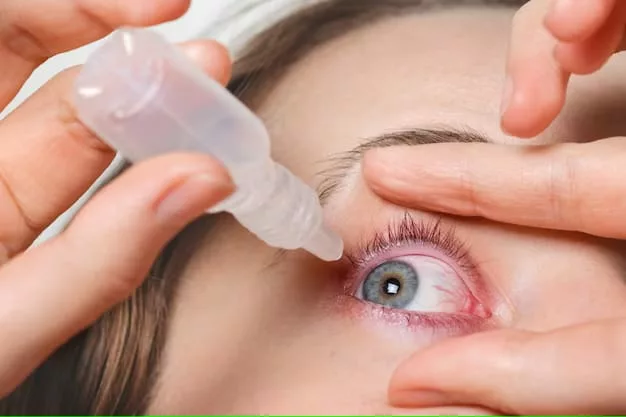
Use of Antimicrobials
Topical antimicrobials like metronidazole (0.75% and 1%), azithromycin, ivermectin, cyclosporine-based emulsion drops, and povidone-iodine effectively treat mild ocular rosacea symptoms.
Doctors may prescribe oral antibiotics like tetracycline, doxycycline, or azithromycin when topical treatments are insufficient. Furthermore, researchers have utilized isotretinoin for this condition but need to conduct further studies to confirm its effectiveness. Doctors also regularly prescribe oral metronidazole; a notable number of patients report complete relief from symptoms with this medication.
FDA-approved treatment for rosacea includes a 40 mg dosage of doxycycline, which contains a mix of 30 mg immediate-release and 10 mg delayed-release forms. The prescribed administration dosage is once daily.11Valentín, S., Morales, A., Sánchez, J. L., & Rivera, A. (2009). Safety and efficacy of doxycycline in the treatment of rosacea. Clinical, cosmetic and investigational dermatology, 2, 129–140. https://doi.org/10.2147/ccid.s4296
It has also been advised to supplement the diet with omega-3 fatty acids, as they have proven effective in improving the functioning of the meibomian glands in ocular rosacea.12Oltz, M., & Check, J. (2011). Rosacea and its ocular manifestations. Optometry (St. Louis, Mo.), 82(2), 92–103. https://doi.org/10.1016/j.optm.2010.01.015
IPL (Intense-Pulse Light) Use
Doctors have successfully used high-intensity light within a wide spectrum of wavelengths, ranging from 500-1200 nm, to treat the cutaneous form of rosacea. Incidentally, patients also report relief in ocular symptoms following treatment with IPL, so doctors now include it as an adjunctive part of treatment. Researchers believe IPL relieves ocular symptoms by thrombosing dilated blood vessels, thereby preventing the spread of inflammatory mediators in the nearby tissues.13 Sagaser, S., Butterfield, R., Kosiorek, H., Kusne, Y., Maldonado, J., Fautsch, M. P., Patel, D., & Shen, J. F. (2021). Effects of Intense Pulsed Light on Tear Film TGF-β and Microbiome in Ocular Rosacea with Dry Eye. Clinical ophthalmology (Auckland, N.Z.), 15, 323–330. https://doi.org/10.2147/OPTH.S280707
IPL aims to eliminate bacteria and mites on the eyelashes, potentially reducing an additional inflammatory trigger.
Combined Therapy
Numerous cases have shown that a combination of the earlier modalities—such as artificial tears, topical/oral antibiotic administration, and lid hygiene—has proven successful.
Conclusion
Accurate diagnosis and appropriate treatment of this condition depend on understanding the etiology, symptoms, and other disorders that resemble it. A complete cure for ocular rosacea is not available. However, effective management strategies exist to reduce discomfort significantly. Regular follow-ups with the healthcare practitioner are essential to prevent flare-ups of the disease and promptly identify and manage potential triggers.
Refrences
- 1Chairman, J., MD, M., Detmar, M., Drake, L., Feinstein, A., Odom, R., & Powell, F. (n.d.). Standard classification of rosacea: Report of the National Rosacea Society Expert Committee on the Classification and Staging of Rosacea. ScienceDirect. https://www.sciencedirect.com/science/article/abs/pii/S0190962202426977
- 2Tidman M. J. (2014). Improving the management of rosacea in primary care. The Practitioner, 258(1775), 27–3
- 3Veira, A. C., & Mannis, M. J. (n.d.). Ocular rosacea: Common and commonly missed. ScienceDirect. https://www.sciencedirect.com/science/article/abs/pii/S0190962213004349
- 4Vieira, A. C., Höfling-Lima, A. L., & Mannis, M. J. (2012).Ocular rosacea–a review. Arquivos brasileiros de oftalmologia, 75(5), 363–369. https://doi.org/10.1590/s0004-27492012000500016
- 5Vieira, A. C., Höfling-Lima, A. L., & Mannis, M. J. (2012). Ocular rosacea–a review. Arquivos brasileiros de oftalmologia, 75(5), 363–369. https://doi.org/10.1590/s0004-27492012000500016
- 6Vieira, A. C., Höfling-Lima, A. L., & Mannis, M. J. (2012). Ocular rosacea–a review. Arquivos brasileiros de oftalmologia, 75(5), 363–369. https://doi.org/10.1590/s0004-27492012000500016
- 7Wilkin, J., Dahl, M., Detmar, M., Drake, L., Liang, M. H., Odom, R., Powell, F., & National Rosacea Society Expert Committee (2004). Standard grading system for rosacea: report of the National Rosacea Society Expert Committee on the classification and staging of rosacea. Journal of the American Academy of Dermatology, 50(6), 907–912. https://doi.org/10.1016/j.jaad.2004.01.048
- 8Veira, A. C., & Mannis, M. J. (n.d.). Ocular rosacea: Common and commonly missed. ScienceDirect. https://www.sciencedirect.com/science/article/abs/pii/S0190962213004349
- 9Glycomics Analyses of Tear Fluid for the Diagnostic Detection of Ocular Rosacea Hyun Joo An, Milady Ninonuevo, Jennifer Aguilan, Hao Liu, Carlito B. Lebrilla, Lenio S. Alvarenga, and Mark J. Mannis Journal of Proteome Research 2005 4 (6), 1981-1987 DOI: 10.1021/pr0501620
- 10Avraham S, Khaslavsky S, Kashetsky N, et al. Treatment of ocular rosacea: a systematic review. JDDG: Journal der Deutschen Dermatologischen Gesellschaft. 2024; 22: 167–174. https://doi.org/10.1111/ddg.15290
- 11Valentín, S., Morales, A., Sánchez, J. L., & Rivera, A. (2009). Safety and efficacy of doxycycline in the treatment of rosacea. Clinical, cosmetic and investigational dermatology, 2, 129–140. https://doi.org/10.2147/ccid.s4296
- 12Oltz, M., & Check, J. (2011). Rosacea and its ocular manifestations. Optometry (St. Louis, Mo.), 82(2), 92–103. https://doi.org/10.1016/j.optm.2010.01.015
- 13Sagaser, S., Butterfield, R., Kosiorek, H., Kusne, Y., Maldonado, J., Fautsch, M. P., Patel, D., & Shen, J. F. (2021). Effects of Intense Pulsed Light on Tear Film TGF-β and Microbiome in Ocular Rosacea with Dry Eye. Clinical ophthalmology (Auckland, N.Z.), 15, 323–330. https://doi.org/10.2147/OPTH.S280707

